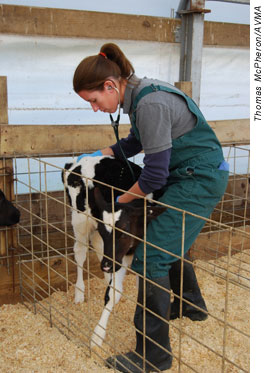FDA analyzing dairy veterinarians' efforts to avoid residues
Regulators want to know what veterinarians are doing to avoid drug residues in the meat of dairy cows sent to slaughter.
 The Food and Drug Administration's Center for Veterinary Medicine wants to survey dairy cattle veterinarians about their use of the Food Animal Residue Avoidance Databank, participation in the Dairy Beef Quality Assurance program, knowledge of risk factors associated with drug residues in dairy cattle tissues, and ability to identify the best way to disseminate drug residue avoidance information to dairy industry clients. According to a Federal Register notice filed July 9, the agency is accepting comments on the proposal through Sept. 7.
The Food and Drug Administration's Center for Veterinary Medicine wants to survey dairy cattle veterinarians about their use of the Food Animal Residue Avoidance Databank, participation in the Dairy Beef Quality Assurance program, knowledge of risk factors associated with drug residues in dairy cattle tissues, and ability to identify the best way to disseminate drug residue avoidance information to dairy industry clients. According to a Federal Register notice filed July 9, the agency is accepting comments on the proposal through Sept. 7.
Shannon Cameron, a spokeswoman for the FDA, said the survey is intended to direct the agency's efforts to promote awareness and provide education about drug residues.
The FDA is responsible for investigating illegal veterinary drug residues in meats and "providing regulatory action when necessary," the notice states. The FDA CVM Office of Surveillance and Compliance tries to reduce the risk of drug residues by promoting veterinary drug residue awareness and avoidance, and the survey is intended to help regulators understand "the current state of veterinary drug residue avoidance in the dairy industry."
Citing data from the Department of Agriculture's Food Safety and Inspection Service's National Residue Program, Cameron said about 90 percent of animals with illegal veterinary drug residues come from dairy farms. Dairy cows account for 63 percent and veal calves from dairy farms account for 27 percent.
The FDA's survey is expected to take about 20 minutes to complete, and it will be distributed through the American Association of Bovine Practitioners, according to the register notice. Dr. M. Gatz Riddell, executive vice president of the AABP, said the organization would likely distribute the survey to members through a link at www.aabp.org, in the organization newsletter, and through e-mails to members.
"Any kind of information that we get that helps address residue issues is important," Dr. Riddell said. "If nothing else, it'll raise the attention level by veterinarians, and that will go on to their producers."
Unfortunately, he said, the veterinarians most likely to provide information through the survey are not the ones who need increased education on residue avoidance.
Dr. Riddell said illegal residues often come about as a result of dairy owners misunderstanding how long an animal needs to be held following treatment and not understanding that the choice of drug, dosage, treatment duration, and route of administration all impact withdrawal time.
Establishing withdrawal times is complicated, and a working understanding of pharmacology and pharmacokinetics is needed, Dr. Riddell said. Veterinary oversight, particularly when animals are treated by dairy operators or staff, is important for establishing withdrawal times.